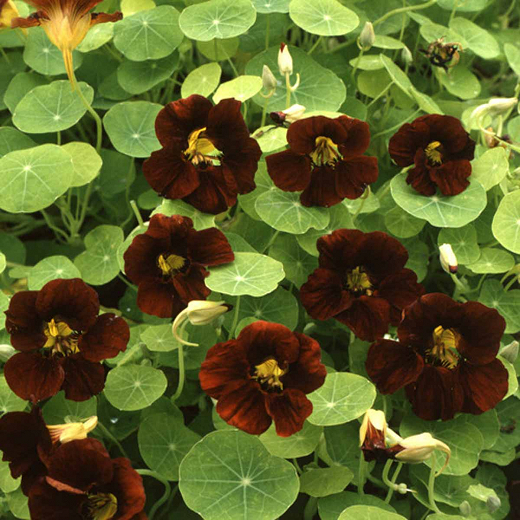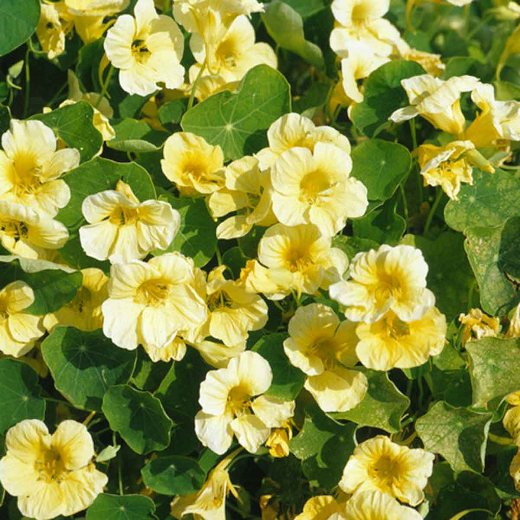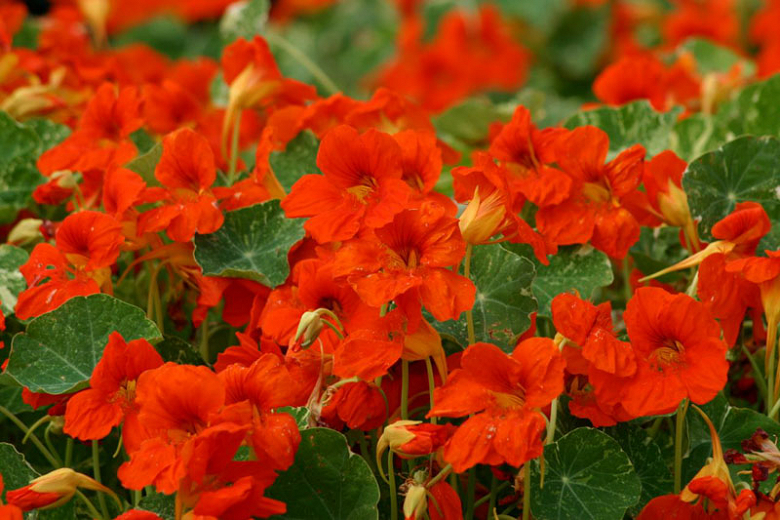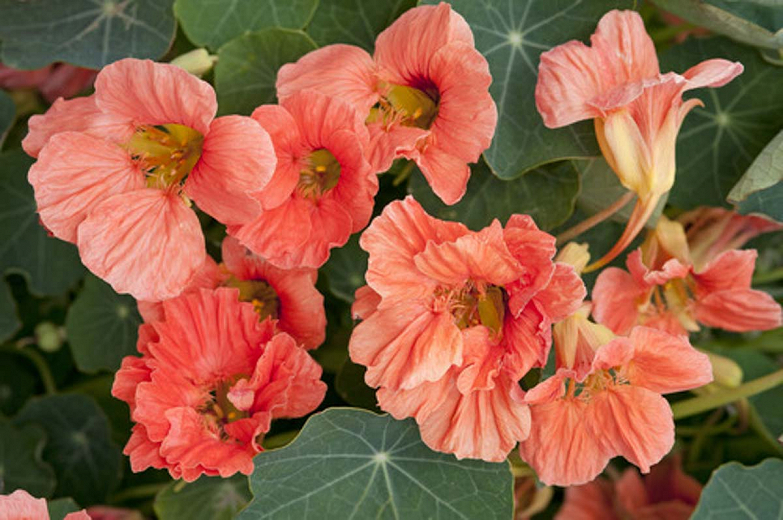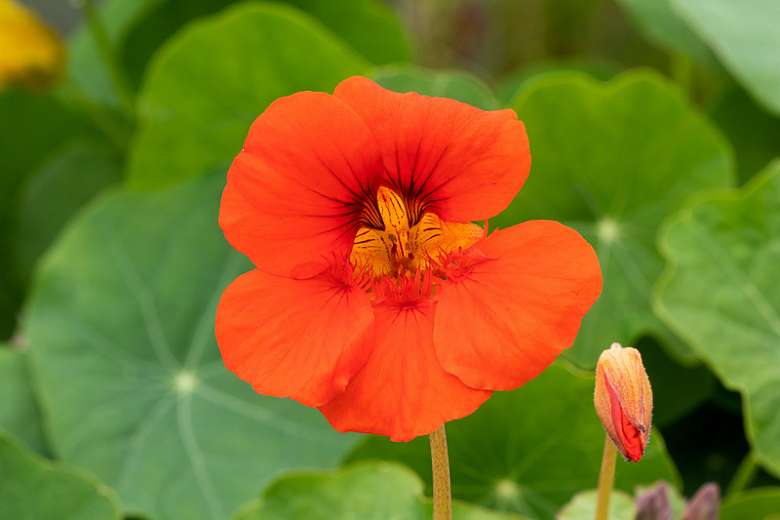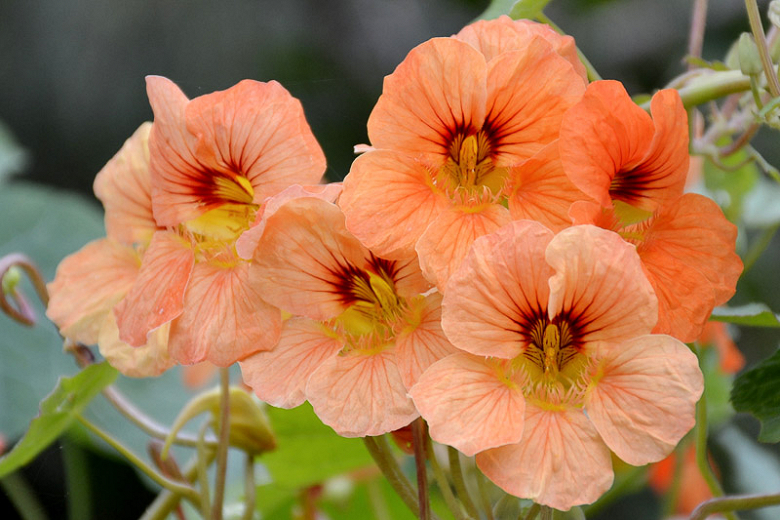Tropaeolum majus Black Velvet (Nasturtium)
Tropaeolum majus ‘Black Velvet’ (Nasturtium) is a compact, bushy annual or short-lived perennial forming a small mound of rounded, parasol-like, light green leaves. Blooming from winter through spring in mild winter areas and from summer to fall in colder climates, it boasts a profusion of long-stalked, funnel-shaped, deep-red flowers that have a velvety texture and appear almost black.
Tropaeolum majus 'Black Velvet' (Nasturtium) is a compact, bushy annual or short-lived perennial forming a small mound of rounded, parasol-like, light green leaves. Blooming from winter through spring in mild winter areas and from summer to fall in colder climates, it boasts a profusion of long-stalked, funnel-shaped, deep-red flowers that have a velvety texture and appear almost black. The blossoms make a fantastic contrast to the light foliage. This petite Nasturtium is ideal for containers and small space gardens.
- Grows up to 12 in. tall and wide (30 cm).
- Thrives in full sun in poor, well-drained soils. Some afternoon shade is appreciated in hot summer areas. Rich, fertile soils are not recommended as they yield more foliage but reduce flowering. Drought-tolerant once established.
- Nasturtium is perennial in hardiness zones 9-11 and grown as an annual plant elsewhere. It relishes cooler temperatures (in the 70sºF or 20sºC) and often sulks in extremely dry or humid conditions.
- Nasturtium is versatile and can be used in beds and borders, rock gardens, edgings, as a ground cover, or in mass plantings.
- It adds a touch of old-fashioned charm in herb gardens, cottage gardens, or patio containers.
- Nasturtium is also an excellent choice to mix with spring-flowering bulbs since it can effectively hide the unattractive bulb foliage that may be allowed to mature.
- Bees, butterflies, hummingbirds, and other pollinators are drawn to the flowers, making Nasturtium a valuable addition to the vegetable garden.
- Nasturtium is a good companion plant for beans, broccoli, cabbage, cucumber, kale, melon, pumpkin, and radish.
- Nasturtium can also be used as a trap crop, trapping pests such as aphids and giving a more appealing and delicious meal than nearby vegetable crops.
- Nasturtiums rank among the most common edible flowers. The delicate blossoms have a sweet, peppery taste similar to watercress. Leaves and unripe seed pods add a citrusy and peppery flavor to salads. Flower buds contain mustard oil and may be used for seasonings. The flowers add eye-catching beauty to the plate and can be used to garnish salads, platters, and savory dishes.
- Few insects or diseases bother Nasturtiums. Watch for blackflies (black aphids), caterpillars, flea beetles, slugs, and glasshouse whiteflies. Deer resistant.
- Deadhead to prolong flowering.
- Propagate by seed. Sow seeds outdoors after all danger of frost has passed or indoors 4-6 weeks before the last spring frost date.
- Avoid fertilization, which tends to increase foliage and decrease flowering.
- Nasturtium will self-seed, keeping a presence in the garden. In warm climates, it blooms and seeds all year round and is considered invasive in many of those areas. It is listed as invasive in coastal California (USA), Hawaii, and Malta, where it has spread rapidly to form large invasive populations to the detriment of native flora or ecosystems.
- Tropaeolum majus is native to Central and South America.
- Nasturtium is toxic to dogs, cats, and horses.
Requirements
| Hardiness | 2 – 11 |
|---|---|
| Heat Zones | 1 – 12 |
| Climate Zones | 1, 1A, 1B, 2, 2A, 2B, 3, 3A, 3B, 4, 5, 6, 7, 8, 9, 10, 11, 12, 13, 14, 15, 16, 17, 18, 19, 20, 21, 22, 23, 24, A1, A2, A3, H1, H2 |
| Plant Type | Annuals |
| Plant Family | Tropaeolum – Nasturtiums |
| Exposure | Full Sun, Partial Sun |
| Season of Interest | Summer (Early,Mid,Late)Fall |
| Height | 1' (30cm) |
| Spread | 1' (30cm) |
| Spacing | 8″ – 12″ (20cm – 30cm) |
| Water Needs | Average |
| Maintenance | Low |
| Soil Type | Chalk, Loam, Sand |
| Soil pH | Acid, Alkaline, Neutral |
| Soil Drainage | Well-Drained |
| Characteristics | Cut Flowers, Showy |
| Tolerance | Deer, Drought |
| Attracts | Bees, Butterflies, Hummingbirds |
| Garden Uses | Beds and Borders, Edging, Ground Covers, Hanging Baskets, Patio and Containers, Small Gardens, Walls and Fences |
| Garden Styles | City and Courtyard, Gravel and Rock Garden, Informal and Cottage |
